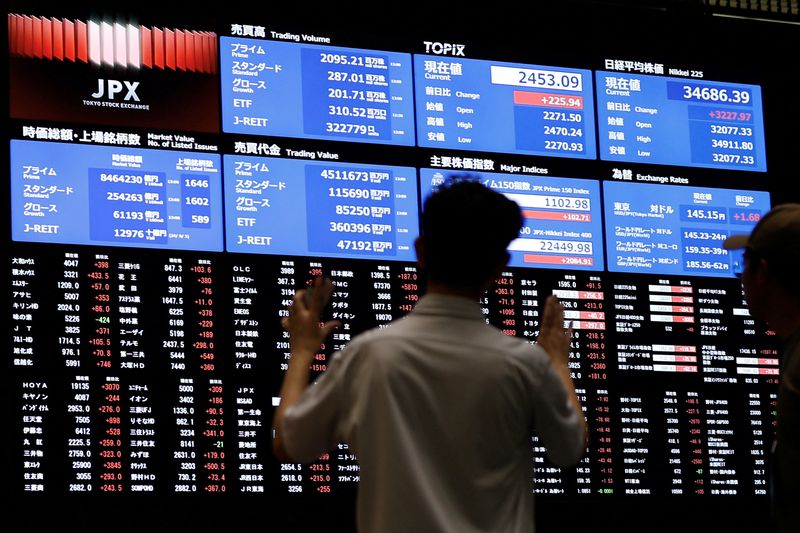By Rae Wee
SINGAPORE (Reuters) -Asian stocks gained on Tuesday while the dollar and U.S. Treasury yields came under pressure, with just a day to go before the expected start of the Federal Reserve’s easing cycle that could see policymakers deliver an outsized rate cut.
Extended holidays in China and South Korea made for thin trading conditions, with investors focused on Wednesday’s Fed decision as odds have crept up in the past week in favour of a 50-basis-point rate cut.
That kept the dollar languishing near its lowest level in over a year against the yen at 140.64, having fallen below the 140-yen level in the previous session.
The stronger yen stoked concerns about Japanese exporters’ earnings and pulled down Tokyo’s Nikkei by 2% as the market returned from a national holiday on Monday.
Outside Japan, MSCI’s broadest index of Asia-Pacific shares rose 0.47%. Hong Kong’s Hang Seng Index advanced 1.44%.
S&P 500 futures and Nasdaq futures both eased marginally, though EUROSTOXX 50 futures tacked on 0.33% and FTSE futures gained 0.57%.
Markets are now pricing in a 67% chance that the Fed could ease rates by half a percentage point at the conclusion of its monetary policy meeting on Wednesday, after a slew of media reports revived the prospect of more aggressive easing.
“The case for a 50bps rate cut this week hinges in part on the idea that rates are well above most estimates of neutral – if officials judge that keeping policy in restrictive territory for too long creates unnecessary risk for the economy then there is no sense in dragging their feet,” said Neil Shearing, group chief economist at Capital Economics.
“The problem is this is a high bar for a large rate cut, particularly at the start of the easing cycle. If nothing else, it creates the impression that central bankers have made a mistake and fallen behind the curve.”
For the year, markets have priced in roughly 120bps worth of easing by December.
The two-year U.S. Treasury yield, which typically reflects near-term rate expectations, was last at 3.5547%, having fallen to a two-year low of 3.5280% in the previous session.
The benchmark 10-year yield was little changed at 3.6232%. [US/]
RATE DECISIONS
The Bank of England (BoE) and the Bank of Japan (BOJ) also meet this week to discuss monetary policy, where both central banks are seen keeping rates on hold.
Expectations of less aggressive easing by the BoE in contrast to the Fed have in turn kept sterling supported. It was last 0.1% lower at $1.3202, but strayed not too far from August’s peak of $1.3269, its strongest level since March 2022.
“We forecast the BoE will keep the bank rate unchanged, at 5.0%, at its September policy meeting,” said economists at ANZ. “We expect it will adopt a gradualist approach in the early part of its easing cycle.”
Elsewhere in Asia, China’s stuttering economic recovery continued to weigh on sentiment, after data over the weekend showed the country’s industrial output growth slowed to a five-month low in August, while retail sales and new home prices weakened further.
Still, concerns over faltering Chinese demand for oil were overshadowed by the ongoing impact of Hurricane Francine on output in the U.S. Gulf of Mexico, sending oil prices rising on Tuesday.
Brent crude futures rose 0.44% to $73.07 a barrel, while U.S. crude futures gained 0.67% to $70.56 per barrel. [O/R]
Spot gold eased 0.22% to $2,576.84 an ounce. [GOL/]

